POPULATION STUDIES
Paper – II
Note : This paper contains fifty (50) objective type questions of two (2) marks each. All questions are compulsory.
1. Which state among the following has highest female age at marriage according to census of India 2011 ?
(1) Goa
(2) Karnataka
(3) West Bengal
(4) Maharashtra
2. Which measure among the following reflect chronic malnutrition of children ?
(1) Height for age
(2) Weight for age
(3) Weight for height
(4) Upper arm circumference
3. Maternal mortality ratio in India has declared from 212 in 2007-09 to 178 in 2011-12.
Which answer below represents the correct percent decline in MMR in these four years ?
(1) About 76%
(2) About 19%
(3) About 16%
(4) About 17%
4. Which of the following is an exact measure of replacement fertility ?
(1) TFR
(2) NRR
(3) GRR
(4) TMFR
5. Given the life table functions qx, lx, Lx, Jx for a complete life table. Which of the following expressions will be used to compute ex (expectation of life at age x) ?
(1) Tx / Lx
(2) Tx / lx
(3) Tx / qx
(4) Tx / lo
6. Which among the following is the highest density area ?
(1) South Africa
(2) South America
(3) North America
(4) West Europe
7. The number of infant deaths in a year ‘y’ is Dy’ and the number of infant deaths in year ‘y + 1’ is D”y + 1 occurred to the births in year ‘y’ is By. The adjusted infant mortality rate calculated by cohort probability method is expressed as :
(1) 
(2) 
(3) 
(4) 
8. Which one of the following is being used currently as a measure of the goal of population stabilization in India ?
(1) Population growth rate
(2) Crude birth rate
(3) TFR
(4) NRR
9. Which country among the following has the largest share of elderly population in 2015 ?
(1) Korea
(2) United Kingdom
(3) Japan
(4) Italy
10. The place that functionally serves many other places is called ;
(1) City
(2) Central Place
(3) Village
(4) City Centre
11. Which among the following is not included in Human Development Index constructed by UNDP ?
(1) Life expectancy at birth
(2) Mean years of schooling
(3) Livable housing
(4) Per capita income
12. According to NFHS – IV data, which of the following states had highest percentage of underweight children under age of 5 years (weight for age) ?
(1) Maharashtra
(2) Madhya Pradesh
(3) West Bengal
(4) Bihar
13. Match the names of the propounder in List – I with the theories they proposed in List – II :


14. Match items in List – I with the associated year of their launch in List – II given below :

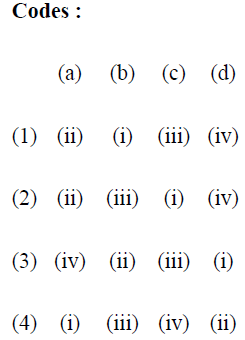
15. The demographic balancing equation is represented by which of the following :
(1) natural change and crude birth rates
(2) natural change and dependency ratio
(3) net migration and dependency ratio
(4) net migration and natural change
16. Match List – I, giving names of the scholars associated with some of the population theories given in List – II :

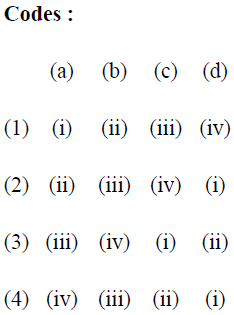
17. Assertion (A) : Most of the states in Southern part of India achieved replacement level of fertility earlier as compared with the states of Northern part of India.
Reason (R) : In Southern states of India, female empowerment and autonomy is higher as compared with the northern states.
(1) Both (A) and (R) are true and (R) is correct explanation of (A).
(2) Both (A) and (R) are true, but (R) is not the correct explanation of (A).
(3) (A) is true, but (R) is false.
(4) (A) is false, but (R) is true.
18. Among the following combination, which one correctly lists five geographically largest states of India (census – 2011), according to their descending order ranking.
(1) Rajasthan, Madhya Pradesh, Maharashtra, UP, J&K.
(2) Madhya Pradesh, Maharashtra, Rajasthan, UP, Gujarat.
(3) Rajasthan, Madhya Pradesh, Maharashtra, J&K, Gujarat.
(4) UP, Rajasthan, Maharashtra, Madhya Pradesh, J&K.
19. Among the following statements, which one correctly lists five most populous countries of the world, according to their ranking in descending order (higher to lower in 2015) ?
(1) China, India, Indonesia, U.S.A., Russia
(2) China, India, U.S.A., Indonesia, Brazil
(3) China, India, U.S.A., Brazil, Indonesia
(4) China, India, U.S.A., Russia, Indonesia
20. Match Millennium Development Goals established by the United Nations in the year 2000, given below in List – I with the number assigned to them given in List – II :

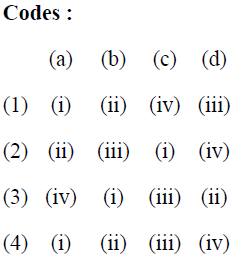
21. According to 2011 census, how many class-I cities with 1,00,000 and above population were in India ?
(1) 303
(2) 403
(3) 503
(4) 603
22. While propagating central place theory of urban system which among the following was not considered by Walter Christaller ?
(1) Isotropic region
(2) Evenly distributed population
(3) Consumers are of same income level
(4) Continuous development and technology change
23. Match the denominators shown in List – II with fertility indicators shown in List – I :


24. Which among the following is the largest megacity of India ?
(1) Delhi
(2) Mumbai
(3) Kolkata
(4) Chennai
25. Match the surveys given in List – I with their year of initiation given in List – II :

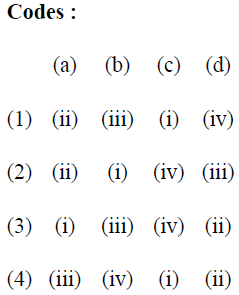
26. After reaching Delhi river Yamuna is considered as a dead river. Which of the following is the reason for the same ?
(1) It is chocked with plastic waste and garbage.
(2) It’s water is diverted for irrigation and channel dried up.
(3) It is unable to dissolve oxygen any more.
(4) It is full with industrial effluent.
27. Which among the following is reasons for migration is not covered in the census of India ?
(1) Marriage
(2) Education
(3) Natural Calamities
(4) Work/Employment
28. Which one of the following is not correct about NFHS-IV ?
(1) NFHS-IV has covered 29 states.
(2) NFHS-IV has covered 5,71,660 households.
(3) NFHS-IV has covered 28,583 primary sampling units (PSUs).
(4) NFHS-IV will provide information on HIV prevalence for women age 15-49 and men age 15-54 at national and state levels.
29. Which one among the following is considered as a major factor for female headship in the household ?
(1) Higher level of education of the female member.
(2) Higher income of the female member.
(3) Young age of the female member.
(4) Absence of adult male member.
30. Assertion (A) : Women are more in marriage migration and less in economic migration in India.
Reason (R) : Women’s mobility in India is restricted by socio-cultural reasons.
Codes :
(1) Both (A) and (R) are true and (R) is correct explanation of (A).
(2) Both (A) and (R) are true, but (R) is not the correct explanation of (A).
(3) (A) is true, but (R) is false.
(4) (A) is false, but (R) is true.
31. Population growth rate of a country for a well-defined period can be measured by calculating “Arithmetic growth rate” (A), “Geometric growth rate” (G), and “Exponential growth rate” (E). Which one of the following expression is correct ?
(1) A > G > E
(2) A > E > G
(3) E > G > A
(4) E > A > G
32. Which one of the following is not a measure of association for case-control studies ?
(1) Ratio
(2) Odds ratio
(3) Attributable fraction
(4) Population attributable risk percent
33. Which one of the following is not true about Pradhan Mantri Surakshit Matritva Abhiyan (PMSMA) ?
(1) PMSMA is part of the Reproductive, Maternal, Neonatal, Child and Adolescent health (RMNCH+A) strategy.
(2) PMSMA will be held on 9th of every month at identified public health facility.
(3) Target beneficiaries will be all pregnant women who are in their 2nd and 3rd trimester of pregnancy.
(4) Health facilities, where obstretics & Gynaecology (OBGY) specialists is not available, services from private practitioner (OBGY) on fixed payment basis are to be arranged.
34. Rapid growth in a population is indicated by which of the following ?
(1) With a smaller proportion of the population in the younger ages.
(2) With a larger percentage of people in the younger ages.
(3) With a larger percentage of people in the adult ages.
(4) All of the above.
35. Match items in List – I with their description in List – II :

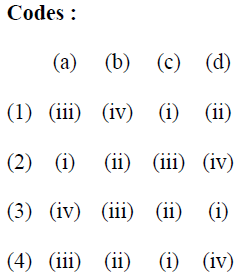
36. Assertion (A) : Population projection by component method gives better estimates.
Reason (R) : Component method includes both age and sex composition of the population.
Codes :
(1) Both (A) and (R) are true and (R) is the correct explanation of (A).
(2) Both (A) and (R) are true, but (R) is not the correct explanation of (A).
(3) (A) is true, but (R) is false.
(4) (A) is false, but (R) is true.
37. Measurement of Singulate Mean Age of Marriage (SMAM) was developed by
(1) A.J. Coale
(2) J. Hajnal
(3) Chandrashekar and Deming
(4) Kingsley Davis
38. Assertion (A) : Investing in Family Planning is a cost-effective method to achieve development goals.
Reason (R) : Family planning ease resource burden leading to availability of higher per capita resources for developmental activities.
Codes :
(1) Both (A) and (R) are true and (R) is the correct explanation of (A).
(2) Both (A) and (R) are true, but (R) is not the correct explanation of (A).
(3) (A) is true, but (R) is false.
(4) (A) is false, but (R) is true.
39. If a country’s rate of natural increase has declined, then which of the following is correct for the doubling time of its population :
(1) been reduced to zero
(2) decreased
(3) increased
(4) remained the same
40. According to Agenda of sustainable development adopted by 193 countries at the United Nations in 2015, how many goals and targets given below are to be achieved by 2030.
(1) 18 goals and 130 targets
(2) 21 goals and 151 targets
(3) 15 goals and 170 targets
(4) 17 goals and 169 targets
41. Which of the following is not the health goal for India during 12th Five Year Plan ?
(1) Reduction of IMR to 25
(2) Reduction of MMR to 100 per 1,00,000 live birth
(3) Raising child sex ratio in the 0-6 age group from 914 to 950
(4) Reduction of T.F.R. below 2.0
42. Choose the correct quality of age-data category given below, for which the five point formula used for smoothing data is appropriate ?
(1) Moderate
(2) Accurate
(3) Not accurate
(4) Highly accurate
43. Settlement pattern of a place reflects upon which of the following combination ?
(a) Physical endowment of the place
(b) Social interaction
(c) Infrastructure facility
(d) Gender segregation
Codes :
(1) (a), (b), (c)
(2) (b) & (c)
(3) (c) & (d)
(4) (b), (c) & (d)
44. Assertion (A) : The Universal Health Coverage is expected to result in financial protection of the poor.
Reason (R) : Poor will have to spend less on treatment and they will also save catastrophic expenditure on health.
Codes :
(1) Both (A) and (R) are true and (R) is correct explanation of (A).
(2) Both (A) and (R) are true, but (R) is not the correct explanation of (A).
(3) (A) is true, but (R) is false.
(4) (A) is false, but (R) is true.
45. During which of the following year, National Sample Survey Organisation (NSSO) did not collect data on problems of elderly population ?
(1) 52nd Round (July, 1995 to June, 1996)
(2) 55th Round (July, 1999 to June, 2000)
(3) 58th Round (July – December, 2002)
(4) 60th Round (January – June, 2004)
Read the following table and answer questions (46 to 50) :
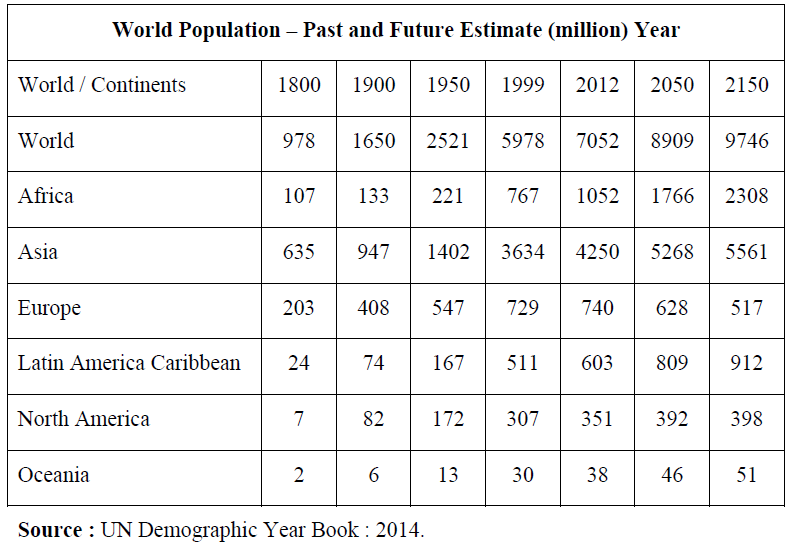
46. Which continent among the following has low projected population in the year 2150 ?
(1) Asia
(2) Europe
(3) Africa
(4) North America
47. Which sequence of the following continents is correct in ascending order (low to high) for the projected population in the year 2050 ?
(1) North America, Europe, Latin America & Caribbean, Africa.
(2) North America, Latin America & Caribbean, Africa, Europe.
(3) Europe, Latin America & Caribbean, Africa, North America.
(4) Africa, Europe, North America, Latin America and Caribbean.
48. During which period the population doubled in Europe ?
(1) 1800-1900
(2) 1900-1950
(3) 1950-1999
(4) 1999-2012
49. Which continent has shown continuously large size of population ?
(1) Asia
(2) Africa
(3) Europe
(4) North America
50. Which sequence of countries among the following is correct according to descending order of (high to low) projected population for the year 2150 ?
(1) Asia, Africa, Europe, Latin America & Caribbean.
(2) Latin America & Caribbean, Europe, Africa, Asia.
(3) Asia, Africa, Latin America & Caribbean, Europe.
(4) Europe, Latin America & Caribbean, Asia, Africa.
Latest Govt Job & Exam Updates: